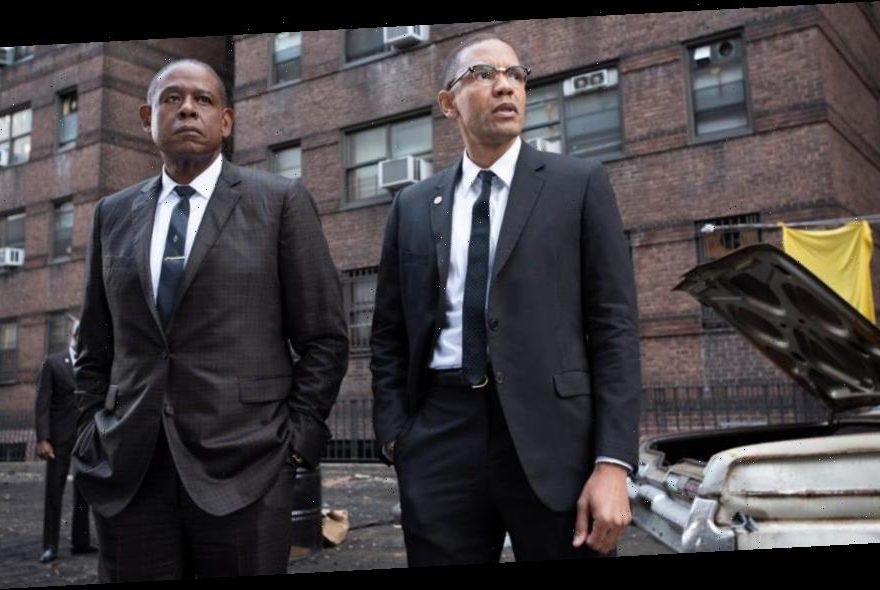“Godfather of Harlem” is inspired by the real-life story of infamous crime boss Ellsworth “Bumpy” Johnson (Forest Whitaker), who, in the early 1960s, returned home from a 10-year stint in Alcatraz, to find the neighborhood he once ruled in shambles. With the streets now controlled by the Italian mob, Bumpy must take on the Genovese crime family, which requires he form alliances with Civil Rights leaders. A gangster story entwined with the sociopolitical battles of the period, the new series certainly has high goals. It will appeal to fans of period gangster dramas looking to be purely entertained. But even with its ambitions, its embracing of the genre’s cliches, its at-times strained credulity, and overstuffed plot lines may keep new audiences away.
Within a few minutes into the first episode, a fearless and armed Bumpy, fresh out the can, confronts his main adversary, Vincent “The Chin” Gigante (Vincent D’Onofrio), now the face of the Genovese family. The soft-spoken Bumpy, who is as much a gentleman as he is a vicious gangster, wants to reclaim what was once his, but Gigante doesn’t intend to oblige.
And so the turf war begins against the backdrop of a city in social upheaval, as the criminal underworld and the nascent Civil Rights movement collide.
A highlight of the series is its attempt to detail the real-life complicated relationships that existed between Bumpy and key African-American leaders, who sought to exploit his infamy and reach. They include Malcolm X (Nigél Thatch, reprising his “Selma” role) and Congressman Adam Clayton Powell, Jr. (a playful Giancarlo Esposito). They aren’t just background fodder. Their ambitions and motivations are defined, each on different paths to power, with ideas on how to lead the movement forward in an America that seemingly wasn’t ready for it.
Additionally, the role of Bumpy Johnson — a man who was admired despite his brutal criminality, because of his strong sense of family and personal independence — provides Whitaker with yet another dynamic character, adding to a resume that’s chockfull of eclectic roles. His quiet charisma is perfectly suited for Bumpy’s controlled compulsion for violence cascading under a calm exterior.
And the rest of the main cast — which also includes Ilfenesh Hadera as Mayme Johnson, Bumpy’s wife; as well as Kelvin Harrison, Jr. and Lucy Fry as doomed interracial lovers — chew on the material they are given to work with, even if it’s sometimes thin.
Notably, the series’ depictions of its Italian mobsters lean more towards caricature. They lack fuller and more sympathetic glimpses into the Italian-American experience of the era, even as it frames that glimpse through the lens of organized crime, and “Godfather of Harlem” suffers for it.
As the series progresses, characters introduced early see their individual stories become fleshed out and unfold. Each plot line intertwines with Bumpy’s story in one way or another, which starts to exhausts credulity, as episodes start to feel overstuffed and predictable.
Another weakness is that Bumpy never really seems to be in any real danger, which takes away some of the suspense. He’s always a step ahead of his enemies or competition, and manages to wiggle out of every dire situation. There’s always a phone call to be made, or a backroom deal to be done. He knows everybody that matters in this world, as well as what their respective relationships and vulnerabilities are, and this makes him almost godlike, and in danger of becoming uninteresting.
Although, by the end of the fifth episode (the first five episodes were made available to the press) of a 10-episode first season, Gigante maybe finally turns the tables on Bumpy, when he rigs a numbers lottery that deals Bumpy a catastrophic financial loss.
The last five episodes of the season will likely be propelled primarily by Bumpy’s fight to get Gigante’s foot off his neck.
“You and I will continue to be at war until one of us is dead,” Bumpy says to Gigante. And that sentence alone summarizes what will be a season-long turf war; plenty of tit-for-tat and quid pro quo, between the powerful, including the gangsters, politicians, corrupt cops, spiritual leaders, some who were real-life people, others composites or outright fictional characters.
Needless to say, there’s plenty of violence in “Godfather of Harlem,” some of it quite gruesome. In a particularly brutal scene, Bumpy uses a blade to carve up a naked opponent’s body, as the vulnerable man struggles to fight back, unsuccessfully. Bumpy then shoots the man in his genitals, before slitting his throat.
Additionally, the language is representative of the times. So audiences sensitive to racial and ethnic slurs, which run the gamut in the series, may be turned off by the prolific use of each word.
Clearly, a great deal of research went into realizing the series. But dramatic license was also taken to create scenes and characters, while aiming to keep the spirit of the times and of the characters as they existed. Having some knowledge of the real-life characters and what their relationships were, would certainly enhance the viewing experience.
Like other new EPIX series, including “Pennyworth,” “Godfather of Harlem” serves simply as enjoyable entertainment. And despite Bumpy’s higher goals in a series that hones in on issues of the era that were especially of importance to black Americans, ultimately it’s aiming more for popcorn watchability than for Emmys, and can really only be appreciated on those terms.
Created by “Narcos” co-creators Chris Brancato and Paul Eckstein, “Godfather of Harlem” premieres Sunday, September 29, at 10pm EST/7PM PST.
Grade: C+
Source: Read Full Article
